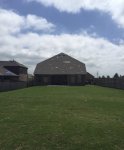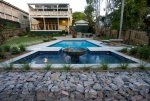Hi all,
After discussing a pool for many years my husband and I are about to pull the trigger on our contract for an in ground gunite pool. I've been lurking for months but had a question for all of you DFW/expansive soil pool owners.
The dream layout (for me) is to have the largest dimensions of the pool run the length of our house, with the spa on the right side of the picture below. I have been concerned by the rather sharp slope to the left side of the picture. (I apologize for the size and angle of the photo. I don't currently have a picture that shows a better view of our lot.) Our first choice is going to build up that side with a retaining wall. The other pool builders all oriented their renderings in a perpendicular fashion to our house, one saying he would never build near a slope of that size.
My question is how concerned should I really be with future movement and/or significant cracks in the gunite on the lower side of the yard (with a retaining wall)? Are we signing up for a nightmare in the making if we go with our first choice? Thank you for any help!

(P.S. Ignore the busted windows and patched roof. Our town received hail over 5+" in diameter this spring. This picture was used as documentation for our insurance company.)
After discussing a pool for many years my husband and I are about to pull the trigger on our contract for an in ground gunite pool. I've been lurking for months but had a question for all of you DFW/expansive soil pool owners.
The dream layout (for me) is to have the largest dimensions of the pool run the length of our house, with the spa on the right side of the picture below. I have been concerned by the rather sharp slope to the left side of the picture. (I apologize for the size and angle of the photo. I don't currently have a picture that shows a better view of our lot.) Our first choice is going to build up that side with a retaining wall. The other pool builders all oriented their renderings in a perpendicular fashion to our house, one saying he would never build near a slope of that size.
My question is how concerned should I really be with future movement and/or significant cracks in the gunite on the lower side of the yard (with a retaining wall)? Are we signing up for a nightmare in the making if we go with our first choice? Thank you for any help!

(P.S. Ignore the busted windows and patched roof. Our town received hail over 5+" in diameter this spring. This picture was used as documentation for our insurance company.)
SaveSave


